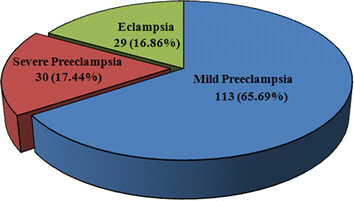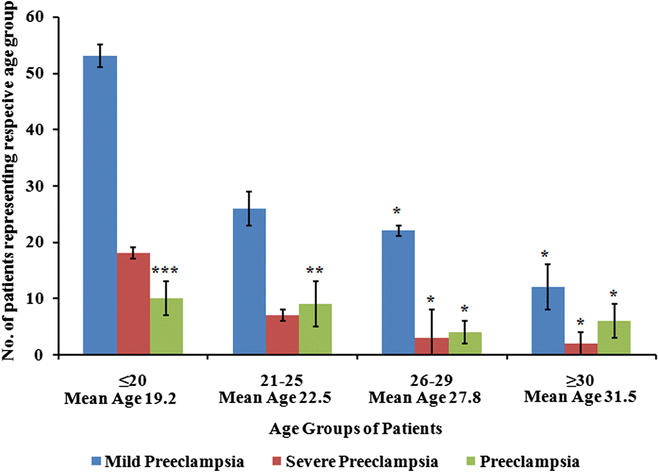Assessment of prevalence of preeclampsia from Dilla region of Ethiopia
- PMID: 26704295
- PMCID: PMC4690301
- DOI: 10.1186/s13104-015-1821-5
Assessment of prevalence of preeclampsia from Dilla region of Ethiopia
Abstract
Background: Preeclampsia is a multi-organ system disorder that occurs after the 20th week of gestation in pregnancy and is characterized by hypertension and proteinuria. In Africa more than 270,000 women die from maternal deaths, worldwide approximately 76,000 women and 500,000 babies die yearly due to preeclampsia. It affects about 8-10% of all pregnancies. Studies have shown that up to 77% women affected with preeclampsia lack knowledge about preeclampsia, and therefore cannot take preventative measures. The aim of study is to evaluate the outcomes and quality of care given to preeclamptic patients treated in Dilla University Referral Hospital.
Methods: The study is a retrospective, hospital based study. One hundred and seventy two records of women were retained for final study out of 7702 patients from January 2009 to December 2012.
Results: The incidence rate of preeclampsia in Dilla University Referral Hospital was found to be 2.23%. The common mean ages found to be affected for preeclampsia were 19.2, 22.5 and 27.8 and 31.5 with a trend towards increasing severity with younger age population.
Conclusion: A guideline on the management and prevention of preeclampsia needs to be produced for Ehiopia.
Figures


Similar articles
-
Preeclampsia and associated factors among pregnant women attending antenatal care in Dessie referral hospital, Northeast Ethiopia: a hospital-based study.BMC Pregnancy Childbirth. 2015 Mar 29;15:73. doi: 10.1186/s12884-015-0502-7. BMC Pregnancy Childbirth. 2015. PMID: 25880924 Free PMC article.
-
Trends of preeclampsia/eclampsia and maternal and neonatal outcomes among women delivering in addis ababa selected government hospitals, Ethiopia: a retrospective cross-sectional study.Pan Afr Med J. 2016 Nov 26;25(Suppl 2):12. doi: 10.11604/pamj.supp.2016.25.2.9716. eCollection 2016. Pan Afr Med J. 2016. PMID: 28439336 Free PMC article.
-
Maternal and perinatal outcome of preeclampsia without severe feature among pregnant women managed at a tertiary referral hospital in urban Ethiopia.PLoS One. 2020 Apr 9;15(4):e0230638. doi: 10.1371/journal.pone.0230638. eCollection 2020. PLoS One. 2020. PMID: 32271787 Free PMC article.
-
Preeclampsia: an update.Acta Anaesthesiol Belg. 2014;65(4):137-49. Acta Anaesthesiol Belg. 2014. PMID: 25622379 Review.
-
[Hypertensive disorders in pregnancy].Ther Umsch. 1999 Oct;56(10):561-71. doi: 10.1024/0040-5930.56.10.561. Ther Umsch. 1999. PMID: 10549228 Review. German.
Cited by
-
Prevalence of preeclampsia and algorithm of adverse foeto-maternal risk factors among pregnant women in the Central Region of Ghana: A multicentre prospective cross-sectional study.PLoS One. 2023 Jun 29;18(6):e0288079. doi: 10.1371/journal.pone.0288079. eCollection 2023. PLoS One. 2023. PMID: 37384786 Free PMC article.
-
Correlation between CYP11B2 polymorphism and the risk of preeclampsia.Medicine (Baltimore). 2020 Nov 25;99(48):e23322. doi: 10.1097/MD.0000000000023322. Medicine (Baltimore). 2020. PMID: 33235094 Free PMC article.
-
Prevalence and associated factors of pregnancy induced hypertension among pregnant women in public hospitals of Hadiya Zone, Central Ethiopia: A cross-sectional study.PLoS One. 2025 Aug 1;20(8):e0326236. doi: 10.1371/journal.pone.0326236. eCollection 2025. PLoS One. 2025. PMID: 40748988 Free PMC article.
-
Double burden of gestational diabetes and pregnancy-induced hypertension in Ethiopia: A systematic review and meta-analysis of observational studies.PLoS One. 2024 Oct 2;19(10):e0311110. doi: 10.1371/journal.pone.0311110. eCollection 2024. PLoS One. 2024. PMID: 39356701 Free PMC article.
-
Obstetrical and perinatal outcomes of women with preeclampsia at Woldia Comprehensive Specialized Hospital, Northeast Ethiopia.Front Med (Lausanne). 2024 Sep 18;11:1326333. doi: 10.3389/fmed.2024.1326333. eCollection 2024. Front Med (Lausanne). 2024. PMID: 39359928 Free PMC article.
References
MeSH terms
LinkOut - more resources
Full Text Sources
Other Literature Sources
Medical

